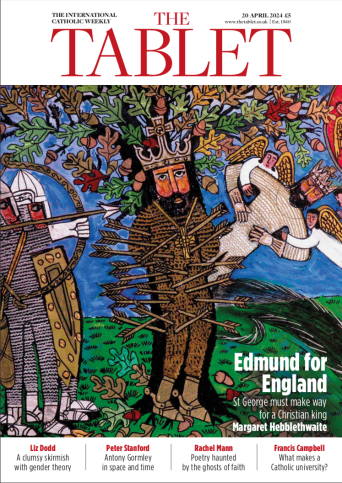In his earlier two books, Rivers of Gold: the rise of the Spanish empire and The Golden Age: the Spanish empire of Charles V, Hugh Thomas staked a claim to match Fernand Braudel for narrative drive, detail, breadth and ambition. Now he brings his monumental trilogy on the Spanish Empire to a triumphant conclusion. It is hard to know what to praise first. The narrative is highly readable. Had Macaulay been the historian of Mexico or Chile, he might have written like this. On one side of World Without End is Philip II’s court, busy with counsels and intrigue; thousands of miles away from the palace of the Escorial, other Spaniards follow his edicts to sweat their way through jungles or preach in Aztec or Quechua to newly converted natives.
Besides the vivid prose is order and method. The book is set out in four parts and 28 chapters. The growth of the Spanish empire covers the period roughly from 1492, when soldiers of King Ferdinand and Queen Isabella had overrun the last Islamic outpost in Spain and Columbus was landing their ships in the Americas, to the death of their great-grandson Philip II in 1598. Philip’s reign saw the conquest and settlement of Mexico, Peru, Chile, and much of what is now Paraguay, and the attempted conquest of Florida. After the conquest of the Philippines – named in honour of their new ruler – in 1580, Philip and his advisers contemplated what would have been the greatest adventure of them all: the invasion of China. Sixty soldiers ought to do it, they thought. But by the time of Philip’s death in 1598 the project had been all but abandoned and the expansion of the empire had come to a halt. It left a rich cultural and linguistic legacy: Christianity rooted in Latin America and parts of Asia and Spanish as the second-most-spoken native language in the world.
This is history driven by personalities rather than economics. The conquered are not ignored, but the conquerors – brutes and bureaucrats, rapacious villains and selfless religious visionaries – are centre stage. And after the enthralling narrative comes over a hundred pages of statistics on taxation and population, genealogies, maps, bibliography, glossary and notes. Yet what most readers will recall are the stories and the people, seen in the bright sunshine of Guyana or Peru. Here are some. In their new dominions, Spaniards were quick to set up schools, universities and the printing press. The consequences were arresting. At Jesuit or Franciscan schools in Mexico, hundreds of natives were before long reading Horace and Cicero. One school, in Tlatelolco, produced Antonio Valeriano, a governor of Mexico City who could translate the Georgics of Virgil and married a niece of Montezuma, and Bautista de Contreras, a friar who turned The Imitation of Christ into Nahuatl. Both men were native Indians.
There are darker aspects. One horrific chapter deals with Lope de Aguirre, a psychopath of “pure evil with superior talents”. In 1560-61 he was part of an expedition seeking gold in the Amazon forests, where he murdered its leader Pedro de Ursúa and thereafter Pedro’s mestiza lover, Inés de Atienza, once famed as “the most beautiful woman in Peru”. As the increasingly deranged Aguirre led hundreds of his followers into Venezuela, there began a catalogue of “terrible murders” that “beggars description”. His mad adventure was the subject of Werner Herzog’s 1972 film Aguirre, Wrath of God.
It is a relief to turn from this to a picture of a wedding, showing one of St Ignatius Loyola’s relations marrying an Inca princess. To the right are Spaniards in ruffs and cloaks, with two Jesuit saints; to the left, Inca dignitaries heavy with gold, with a parasol of feathers and a lady holding a parrot. It brings home the extraordinary hybrid that Spanish America was. Another picture shows Potosí (13,340 feet up in Bolivia) and its “mountain of silver”, the result of which by 1598 was a town with 150,000 people, 36 casinos, a theatre, 14 dance-halls, and 80 churches (and, alas, “many brothels and innumerable prostitutes”). If there was more silver than gold to be found in the New World, the silver still brought fabulous wealth and an economic puzzle. Hugh Thomas attends to the paradox (which mystified writers of the time) that the more silver was found, the less each ingot was worth. He is alert as well to the capitalists in Seville and beyond who financed the conquistadores, whose exploits (heroism notwithstanding) were meant for profit.
A last surprise. This prodigy of learning, where political analysis consorts with a love of the classics of Spanish literature exported to the Americas, has a few slips. Hugh Thomas is generous to the Catholic faith, paying tribute to work of selfless and imaginative missionaries as well as noting the gruesome episodes. But friars do not live in “monasteries”, for they are not monks; Pius V was not “the last pope to be canonised” (p. 50); St Francis Xavier was not from Asturias (p. 55) but Navarre (from where this reviewer writes); and “Huguenot” is nothing to do with a mythical King Hugues (p. 402), but is assimilated (via the name of a Geneva burgomaster) from the Swiss-German “eidgenoss” meaning “confederate”. Yet these are trifles. What matters is that Lord Thomas has masterfully chronicled epoch-making events, one consequence of which (though he never mentions it) is the occupation today of St Peter’s throne by a Latin-American Jesuit, who speaks Spanish with an Argentinian accent.
04 September 2014, The Tablet
World Without End: the global empire of Philip II
All they surveyed
Edmund for England
 Loading ...
Loading ...
Get Instant Access
Subscribe to The Tablet for just £7.99
Subscribe today to take advantage of our introductory offers and enjoy 30 days' access for just £7.99



What do you think?
You can post as a subscriber user...
User Comments (0)